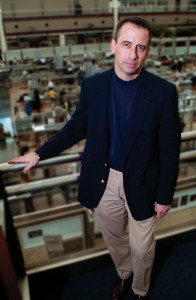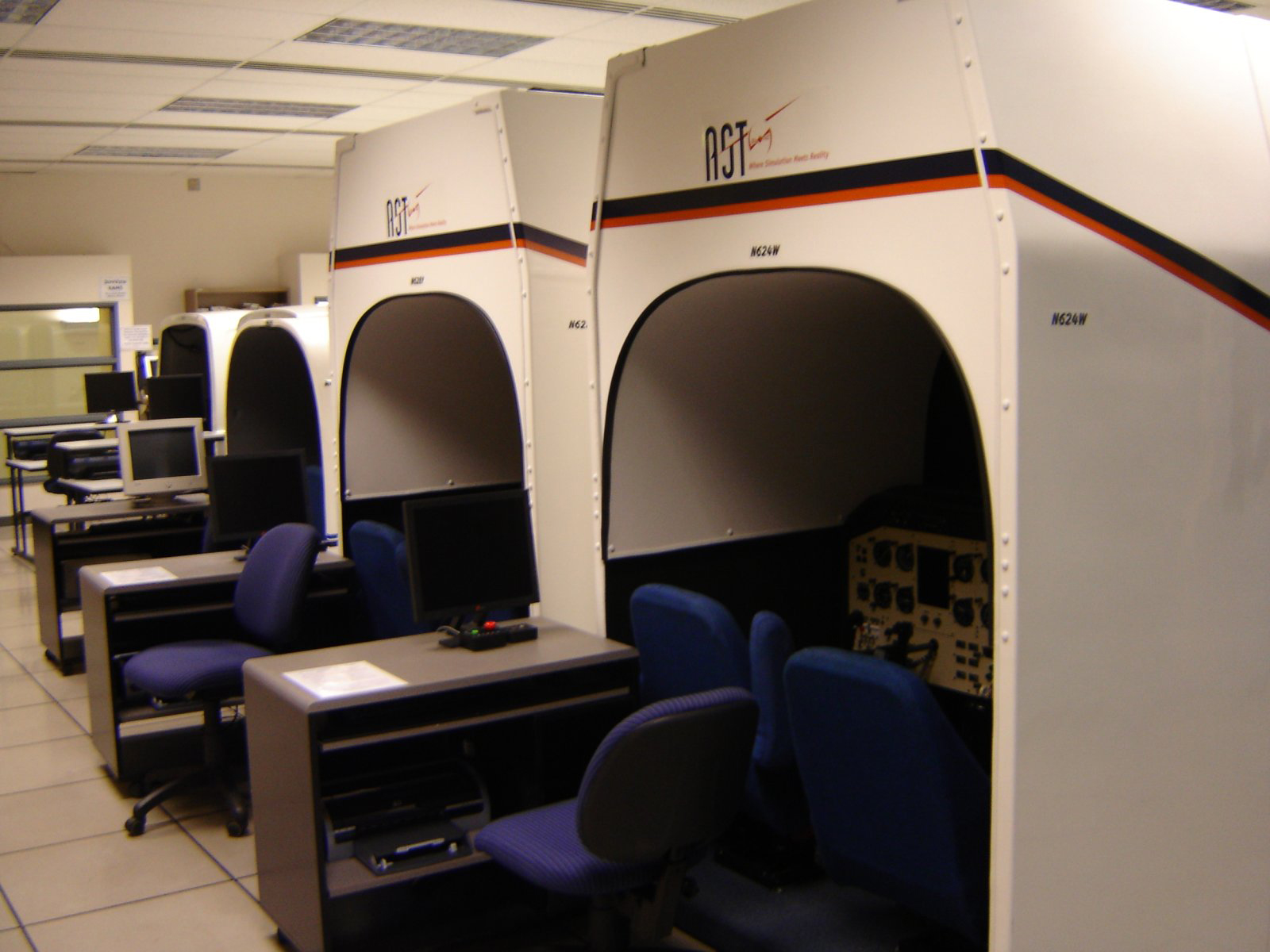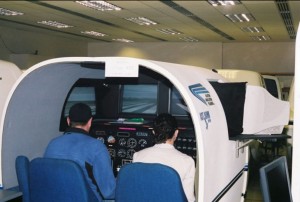By Ray Cober
Located in downtown Denver, the Auraria Higher Education Campus offers students a unique urban learning experience with three higher education institutions. One of those, the Metropolitan State College of Denver, provides a unique learning opportunity—a professional education in all things aviation related.
Metro State College’s Aviation and Aerospace Science Department has operated for decades and is recognized as one of the top professional aviation schools in the nation. It provides access to a diverse range of industry experts, professional programs and the centerpiece of the department, the World Indoor Airport, a unique flight simulation laboratory that features more than 20 flight simulators serving its extensive aviation program.
The brainchild of two department faculty members, Bob Bugg and Robert K. Mock, the World Indoor Airport opened in 1995. Prior to the WIA, flight simulation was done on laptops in a makeshift classroom Mock fondly remembers as the “chicken coop.”
In the late 1980s and early 1990s, Bugg, a retired Air Force electrical engineer, was the only teaching faculty member who was an active Federal Aviation Administration flight instructor. He and Mock, a retired Air Force colonel, were the driving forces behind the WIA and other departmental expansions during those years. After two years of writing and competing for grants, they finally got approval for the ambitious plan.
“Bugg kept bugging me to write the grants,” remembers Mock.
After moving into a dedicated building (a converted warehouse) in 1995, the Aviation and Aerospace Science Department began to see its first serious expansion and construction of the WIA. Wearing a hardhat, Bob Mock visited the site daily to personally oversee construction. He ensured that sufficient room would be available for later growth. The expansion would include a new department luxury—personal offices for the faculty.
Aviation Week featured the WIA and its unique facilities in an article soon after its completion. The WIA gained further fame in 1996, when the department was asked to run the command center and assist Bill Daniels in his record-breaking around-the-world flight in a Learjet 35. While Daniels made his attempt, four Metro students replicated his actions in the WIA. Through a simulator configured to match the Lear’s performance data, they duplicated each leg of the flight.
From Daniels’ takeoff from nearby Centennial Airport, and on to the Bahamas, North Africa, across Asia and back to Centennial, the simulator crew received constantly updated flight and weather data. The students mirrored every part of Daniels’ journey of more than 55 hours. Upon both the simulated and real landing, the students raced to meet Daniels and the crews celebrated together.
Mock recalled some of the efforts going into that memorable flight. The Jeppesen data used to program the Learjet 35 simulator filled two five-foot stacks of info sheets. Jeppesen representatives were so impressed with student Tim Name’s role in the sim crew that they offered him an internship with the company.
The WIA has evolved into an impressive facility, incorporating single-engine, twin-engine and turboprop static sims, as well as air traffic control training facilities, which familiarize students with combined ATC and flight experience. The WIA is currently equipped with 10 single-engine flight training devices configured for the Cessna 172 Skyhawk or 172RG Cutlass, five twin-engine FTDs configured for the Piper PA-44 Seminole and two turboprop FTDs replicating the Beechcraft King Air 200 corporate transport or BE-1900 airliner. In addition, the WIA is equipped with personal computer advanced training devices, which are more powerful and more accurate versions of desktop recreational flight sims. A former United Airlines DC-10 procedural trainer teaches checklist and crew management. Students may log FTD and PCATD time towards actual flight time, as dictated by the FAA.
The WIA experiences constant upgrades and additions. Nearly five years ago, the department accepted a bid for a Raytheon ATC software package identical to that used in major ATC training centers. The procurement and installation process took two years, partly because of some difficulty with voice recognition communication. By the spring of 2005, the software finally provided valuable ATC training.
All 19 FTDs went through a major overhaul program this summer, with the installation of new software and mechanical parts and an electrical system upgrade.
A number of sim classes are designed to teach increasingly progressive flight skills. Courses teach basic flight skills, instrument use and flight planning, advanced instrument flight and navigation, turbine flight and crew resource management. These courses are designed for airline professionalism and training.
Bruce Christian and Kevin Kuhlmann, two sim class professors, are working to ensure that students receive standardized training, for easy transition to airline careers. Christian requires students to memorize flows and performance profiles and to use proper checklist procedures.
“This is how the airlines and the military do things,” he says.
Kuhlmann teaches the Professional Fight Standards Seminar, a course that brings students into the turbine flight sim. He encourages students to combine their total academic experiences and apply them to the realistic, professional atmosphere. Skills, which include advanced navigation and crew resource management, are often applied to group projects that are conducted internally within class and also externally in conjunction with the aviation industry. Students design and execute line-oriented flight training scenarios, programs and manuals. These projects differ from semester to semester and usually involve the guidance and management of someone currently working in the aviation industry.
In this class, students are also exposed to advanced systems typically found in turbine aircraft. These include autopilots and flight directors, as well as high-speed flight operations.
The overall sim experience gives students the benefit of being able to use what they’ve learned, and also to be exposed to some of what they’ll experience post-graduation, especially regarding flight ops. The course offers guest lecturers from all aspects of the industry, and includes major, regional and cargo airline pilots, military fliers, avionics specialists and airline management personnel.
“The sims are about line-oriented flight training, not about how to handle one emergency after another,” says Kuhlmann, emphasizing the course’s focus on crew and resource management. “Emergencies don’t happen on a regular basis in the real world, and it’s only credible to make things realistic.”
He said the course provides a low-threat environment and that students who are able to learn from mistakes and combine other skills will succeed in the industry.
“Students need to understand that this is an industry where opportunities don’t fall into their laps. They need to learn to spit and polish, perform and create opportunities that fit their objectives,” says Kuhlmann.
Nearly every student who has taken then Professional Flight Standards Seminar has received an employment interview. Students may also take the Aviation Management Problems and Job Targeting course, specifically designed to give students the skills to get jobs.
“The class is really about communication, but is presented to students in a way that speaks to them,” says Jeff Price, one of the course professors.
He notes that the interpersonal communication skills taught in the class are both written and verbal.
“These skills really determine your success,” says Price. “You need to be able to express your skills and to be able to market yourself.”
The course mirrors those taught at competing schools, but Metro’s program is more in-depth and specific to the aviation industry. Like the Professional Flight Standards Seminar, Aviation Management Problems and Job Targeting also supplies guest speakers from the industry. The course focus is dependent upon the materials and experiences these speakers bring to the class.
“The class was taught for more than 20 years, but went away a few years ago,” Price said. “Because of the backlash from the industry, internship programs and alumni, the program was reinstituted. Many alumni credit the class for their jobs.”

Jeff Price graduated from Metro State College’s Aerospace and Aviation Sciences program, and now is a professor there.
Price said the course is also designed to challenge the students to build resiliency beyond their comfort zones and limitations. An integral course component is the mock interview conducted at semester’s end. As many as 20 professionals from across the industry donate their time and effort to provide a realistic interview environment and feedback for students.
The Aerospace and Aviation Science Department offers direct opportunities for students to gain experience in the aviation industry, through a variety of internship and employment programs. Mock recalls the early days of an internship program with United Airlines.
“One student was from Metro, one from Southern Illinois and one from Embry-Riddle,” he said. “It eventually blossomed into students from 20 different colleges competing for 40 full-blown internship slots.”
The United Airlines internship program was put on hold after 9/11, but other opportunities and programs still exist. Cherie Krasovich, a Metro professor and United Airlines pilot, is a former student of the department. She recalls how receiving an internship within Stapleton International Airport’s operations department helped her achieve success.
“It gave me great networking opportunities,” she said.
She noted that the internship lead to larger projects and taught her how other departments worked. She was soon an airport service representative.
Krasovich became a manager at a Jefferson County Airport flight school and was able to work with interns of her own, through Metro’s program. She said it was a positive experience.
“The interns hit the ground running, and were motivated and quick learners,” she said. “They gained real experience in the field.”
T.J. DeCino maintains the WIA and all technology within the department. He said students can do sim work for course credit as well as for pay.
“Students have had many opportunities, such as marketing for Jeppesen, maintaining sim equipment, or for general ground operations,” he said. “We don’t do just simulations; we look at trends, at what other schools are doing, and even do research projects.”
He notes that working in the WIA can be a stepping stone towards working at a fixed base operation.
The Aerospace and Aviation Science Department hosts a number of active student groups such as the Metro Flight Team, the American Association of Airport Executives and Alpha Eta Rho. The flight team, a student-based organization, is a course for credit. The team competes against 100 other teams, in flight events around the country, including events at Embry-Riddle, the Air Force Academy and the University of North Dakota. The teams compete in events designed to promote safety throughout the industry.
Competitions can include navigational events where participants have 30 minutes to plan a flight and then must perform that flight according to those calculations. Other events include precision power-on short-field landings, precision power-off landings and “message drops,” where balsa wood containers must be dropped as close to the targets as possible.
Ground events can include aircraft recognition tests, where participants have 30 seconds to properly identify certain aircraft. During the Manual Flight Computer event, participants have an hour to solve 40 flight calculations, using only a manual flight computer, such as an E6B or CR3. For the Simulator Comprehensive Air Nav event, participants take written 40-question tests in 50 minutes, and must perform flight calculations for flights with multiple legs and multiple drop-off and carry-on points for cargo and passengers, based on time, fuel and distance.
In the most recent regional flight competition, in Billings, Mont., the Metro Flight Team took second place in the SCAN event. Team members also took first, sixth and seventh places in the simulator event.
Team member Ben Schuler says the organization “isn’t like a fraternity, but, rather, more like a bunch of friends.” He said the organization is a group of pilots who continually strive to improve themselves and better their skills. While a private pilot rating is required to participate in the flying events, any student of the Aerospace and Aviation Science Department is free to join the flight team and participate in ground events.
“The flight team teaches us to use skills to the best of our ability and shows what other students in other schools are doing,” he said.
Student Ryan Breznau notes that since Metro doesn’t provide any funding for the competition trips, every student must pay his or her own way. For that reason, fundraising has become very important.

Bill Daniels and his crew are shown at Centennial Airport, after their record-breaking flight. Metro aviation students closely followed the flight.
One recent fundraiser offered helicopter rides at the Auraria Campus. Premier Helicopters of Jefferson County Airport provided an R-44 Raven for the event. Special access had to be allowed, and a soccer class moved indoors to provide enough landing space. The fundraiser helped get the Metro Flight Team to Billings, helped raise awareness of the Aerospace and Aviation Science Department and provided a fun time for everyone. The group also raises funds through aircraft washes and raffles.
The American Association of Airport Executives also has a student chapter present at Metro, and is more specifically geared towards those aspiring to become airport managers. AAAE is the largest association of airport professionals in the world.
“We get to mingle with contacts in the industry, and attend the annual AAAE conference, to further our careers,” said Andrew Johnson, the president of the Metro chapter.
Sixteen members of the Metro AAAE chapter attended this year’s conference, held in San Diego, Calif. During the conference, the Metro chapter worked closely with the Northwest chapter, concentrated in Washington, helping to man the NA booth in exchange for sponsorship. The chapter also met with the Colorado Airport Operators Association last May in Glenwood Springs, Colo.
The Metro AAAE chapter, which contributes to the Children’s Hospital of Denver and adopt-a-highway programs, plans to organize an aviation career fair on Feb. 27, 2007. The chapter also works closely with Robert Olislagers, executive director of Centennial Airport, a local sponsor.
Many Metro AAAE members go on to permanent positions at local airports, such as Jefferson County Airport and Denver International Airport.
Alpha Eta Rho is a coeducational fraternity, dedicated to providing extensive networking opportunities, exposing students to professional opportunities and experiences in the aviation industry. The Sigma Phi chapter is working hard to establish itself as a promotional presence for aviation throughout the Auraria Campus. Additionally, the group is very involved in local communities, helps maintain Peña Boulevard, the major roadway leading to Denver International Airport, and provides supply flights for charitable organizations.
Matt Bradford, a Sigma Phi chapter member, is grateful for the opportunities the group offers.
“If it wasn’t for Alpha Eta Rho, there’s a good chance I wouldn’t be in the industry anymore,” he said.
Professor Price agrees that the student groups involved in the Aerospace and Aviation Science Department offer great opportunities to work within industry.
“The people who get hired are the people who can take charge and get things done,” he said. “Student groups provide a path to both, taking charge through leadership roles, and taking on projects to show that you can get things done.”
Other department educational opportunities delve into areas of aviation not as directly associated with flying. “Skip” Balazs, one of the professors involved in the Daniels-WIA record-breaking attempt, hosts a seminar program in Washington, D.C. Five to eight Metro students and sixty students from other colleges interact directly with aviation lobby groups and learn about current events in the industry. Students are required to pay their own way and upon their return, must perform a seminar on what they learned and experienced.
Dr. James Simmons teaches a number of management classes, including airline and airport management, business, air cargo, and background classes into law, security and safety.
“Students are all over the place,” he says of the diversity of programs.
Kevin Kuhlmann teaches a course on human physiology in relation to flight. He notes that 70 to 80 percent of aviation accidents are attributed to human factors. The course starts out with a basic understanding of anatomy and physiology applied to the flying environment, then moves into factors such as fatigue, stress and environment. Other topics, including post-crash survival issues, are also discussed in detail.
Such programs are indicative of the type of growth and expansion made to the Aerospace and Aviation Science Department over the decades. As former students-turned professors Price and Krasovich recall, students of the department more than 20 years ago had to make do with much less.
“The quality of education has certainly improved,” says Krasovich, noting the addition of turbine sims, a broader base of knowledge and the personal growth of students.
“The Metro student may not be as glamorous, but that student still gets the job done,” notes Price.
For more information on Metropolitan State College of Denver’s Aerospace and Aviation Department, call 303-556-2983, or visit [http://www.mscd.edu/~aviation].













